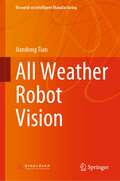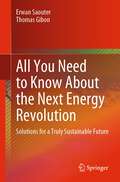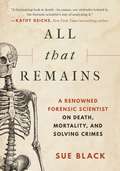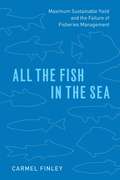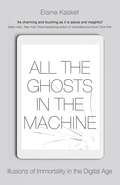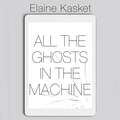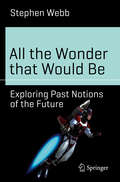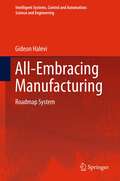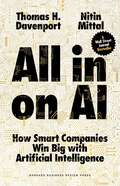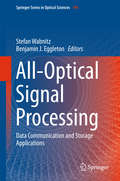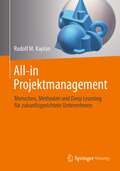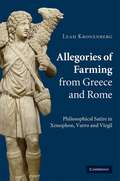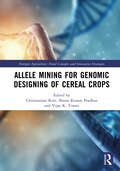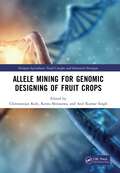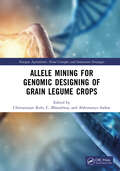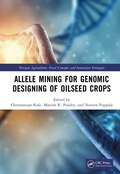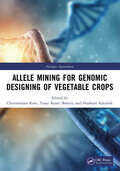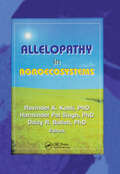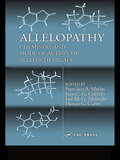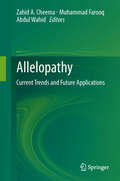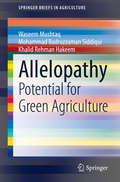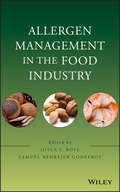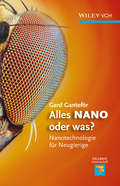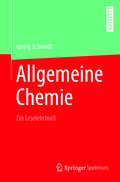- Table View
- List View
All Weather Robot Vision (Research on Intelligent Manufacturing)
by Jiandong TianComplex illumination and meteorological conditions can significantly limit the robustness of robotic vision systems. This book focuses on image pre-processing for robot vision in complex illumination and dynamic weather conditions. It systematically covers cutting-edge models and algorithms, approaching them from a novel viewpoint based on studying the atmospheric physics and imaging mechanism. It provides valuable insights and practical methods such as illumination calculations, scattering modeling, shadow/highlight detection and removal, intrinsic image derivation, and rain/snow/fog removal technologies that will enable robots to be effective in diverse lighting and weather conditions, i.e., ensure their all-weather operating capacity. As such, the book offers a valuable resource for researchers, graduate students and engineers in the fields of robot engineering and computer science.
All You Need to Know About the Next Energy Revolution: Solutions for a Truly Sustainable Future
by Erwan Saouter Thomas GibonClimate change is a reality that cannot now be disputed and solutions exist, whether technological or societal. However, it is essential to understand their capacity to meet a demand for energy and resources that will continue to grow. Faced with the confusion of messages, the multiplicity, and, sometimes, the naivety of the roadmaps for achieving a carbon-neutral world, this concise book proposes a return to the fundamentals that we should all know before we can choose the type of development we want. It invites us to move away from dogmatic positions, preconceived, and partisan ideas and to become aware that all the choices available to us have advantages and disadvantages, and that these must be rigorously quantified in order to prevent today's solutions from becoming tomorrow's disasters.
All that Remains: A Renowned Forensic Scientist on Death, Mortality, and Solving Crimes
by Sue BlackBook of the Year, 2018 Saltire Literary Awards For fans of Caitlin Doughty, Mary Roach, and CSI shows, a renowned forensic scientist on death and mortality. Dame Sue Black is an internationally renowned forensic anthropologist and human anatomist. She has lived her life eye to eye with the Grim Reaper, and she writes vividly about it in this book, which is part primer on the basics of identifying human remains, part frank memoir of a woman whose first paying job as a schoolgirl was to apprentice in a butcher shop, and part no-nonsense but deeply humane introduction to the reality of death in our lives. It is a treat for CSI junkies, murder mystery and thriller readers, and anyone seeking a clear-eyed guide to a subject that touches us all. Cutting through hype, romanticism, and cliché, she recounts her first dissection; her own first acquaintance with a loved one’s death; the mortal remains in her lab and at burial sites as well as scenes of violence, murder, and criminal dismemberment; and about investigating mass fatalities due to war, accident, or natural disaster, such as the 2004 Indian Ocean tsunami. She uses key cases to reveal how forensic science has developed and what her work has taught her about human nature. Acclaimed by bestselling crime writers and fellow scientists alike, All That Remains is neither sad nor macabre. While Professor Black tells of tragedy, she also infuses her stories with a wicked sense of humor and much common sense.
All the Fish in the Sea: Maximum Sustainable Yield and the Failure of Fisheries Management
by Carmel FinleyBetween 1949 and 1955, the State Department pushed for an international fisheries policy grounded in maximum sustainable yield (MSY). The concept is based on a confidence that scientists can predict, theoretically, the largest catch that can be taken from a species' stock over an indefinite period. And while it was modified in 1996 with passage of the Sustained Fisheries Act, MSY is still at the heart of modern American fisheries management. As fish populations continue to crash, however, it is clear that MSY is itself not sustainable. Indeed, the concept has been widely criticized by scientists for ignoring several key factors in fisheries management and has led to the devastating collapse of many fisheries. Carmel Finley reveals that the fallibility of MSY lies at its very inception--as a tool of government rather than science. The foundational doctrine of the MSY emerged at a time when the US government was using science to promote and transfer Western knowledge and technology, and to ensure that American ships and planes would have free passage through the world's seas and skies. Finley charts the history of US fisheries science using MSY as her focus, and in particular its application to halibut, tuna, and salmon fisheries. Fish populations the world over are threatened, and All the Fish in the Sea will help sound warnings of the effect of any management policies divested from science itself.
All the Ghosts in the Machine: Illusions of Immortality in the Digital Age
by Elaine Kasket'As charming and touching as it is astute and insightful'Adam Alter, New York Times bestselling author of Irresistable and Drunk Tank Pink'This a very useful book, even perhaps for people who have never been near a computer in their lives'Jake Kerridge, Sunday TelegraphSeen any ghosts on your smartphone lately? As we're compelled to capture, store and share more and more of our personal information, there's something we often forget. All that data doesn't just disappear when our physical bodies shuffle off this mortal coil. If the concept of remaining socially active after you're no longer breathing sounds crazy, you might want to get used to the idea. Digital afterlives are a natural consequence of the information age, a reality that barely anyone has prepared for - and that 'anyone' probably includes you.In All the Ghosts in the Machine, psychologist Elaine Kasket sounds a clarion call to everyone who's never thought about death in the digital age. When someone's hyperconnected, hyperpersonal digital footprint is transformed into their lasting legacy, she asks, who is helped, who is hurt, and who's in charge? And why is now such a critical moment to take our heads out of the sand?Weaving together personal, moving true stories and scientific research, All the Ghosts in the Machine takes you on a fascinating tour through the valley of the shadow of digital death. In the process, it will transform how you think about your life and your legacy, in a time when our technologies are tantalising us with fantasies of immortality.
All the Ghosts in the Machine: The Digital Afterlife of your Personal Data
by Elaine Kasket'As charming and touching as it is astute and insightful'Adam Alter, New York Times bestselling author of Irresistible and Drunk Tank Pink'This a very useful book, even perhaps for people who have never been near a computer in their lives'Jake Kerridge, Sunday TelegraphSeen any ghosts on your smartphone lately? As we're compelled to capture, store and share more and more of our personal information, there's something we often forget. All that data doesn't just disappear when our physical bodies shuffle off this mortal coil. If the concept of remaining socially active after you're no longer breathing sounds crazy, you might want to get used to the idea. Digital afterlives are a natural consequence of the information age, a reality that barely anyone has prepared for - and that 'anyone' probably includes you.In All the Ghosts in the Machine, psychologist Elaine Kasket sounds a clarion call to everyone who's never thought about death in the digital age. When someone's hyperconnected, hyperpersonal digital footprint is transformed into their lasting legacy, she asks, who is helped, who is hurt, and who's in charge? And why is now such a critical moment to take our heads out of the sand?Weaving together personal, moving true stories and scientific research, All the Ghosts in the Machine takes you on a fascinating tour through the valley of the shadow of digital death. In the process, it will transform how you think about your life and your legacy, in a time when our technologies are tantalising us with fantasies of immortality.
All the Ghosts in the Machine: The Digital Afterlife of your Personal Data
by Elaine Kasket'As charming and touching as it is astute and insightful'Adam Alter, New York Times bestselling author of Irresistible and Drunk Tank Pink'This a very useful book, even perhaps for people who have never been near a computer in their lives'Jake Kerridge, Sunday TelegraphSeen any ghosts on your smartphone lately? As we're compelled to capture, store and share more and more of our personal information, there's something we often forget. All that data doesn't just disappear when our physical bodies shuffle off this mortal coil. If the concept of remaining socially active after you're no longer breathing sounds crazy, you might want to get used to the idea. Digital afterlives are a natural consequence of the information age, a reality that barely anyone has prepared for - and that 'anyone' probably includes you.In All the Ghosts in the Machine, psychologist Elaine Kasket sounds a clarion call to everyone who's never thought about death in the digital age. When someone's hyperconnected, hyperpersonal digital footprint is transformed into their lasting legacy, she asks, who is helped, who is hurt, and who's in charge? And why is now such a critical moment to take our heads out of the sand?Weaving together personal, moving true stories and scientific research, All the Ghosts in the Machine takes you on a fascinating tour through the valley of the shadow of digital death. In the process, it will transform how you think about your life and your legacy, in a time when our technologies are tantalising us with fantasies of immortality.
All the Wonder that Would Be: Exploring Past Notions of the Future (Science and Fiction)
by Stephen WebbIt has been argued that science fiction (SF) gives a kind of weather forecast - not the telling of a fortune but rather the rough feeling of what the future might be like. The intention in this book is to consider some of these bygone forecasts made by SF and to use this as a prism through which to view current developments in science and technology. In each of the ten main chapters - dealing in turn with antigravity, space travel, aliens, time travel, the nature of reality, invisibility, robots, means of transportation, augmentation of the human body, and, last but not least, mad scientists - common assumptions once made by the SF community about how the future would turn out are compared with our modern understanding of various scientific phenomena and, in some cases, with the industrial scaling of computational and technological breakthroughs. A further intention is to explain how the predictions and expectations of SF were rooted in the scientific orthodoxy of their day, and use this to explore how our scientific understanding of various topics has developed over time, as well as to demonstrate how the ideas popularized in SF subsequently influenced working scientists. Since gaining a BSc in physics from the University of Bristol and a PhD in theoretical physics from the University of Manchester, Stephen Webb has worked in a variety of universities in the UK. He is a regular contributor to the Yearbook of Astronomy series and has published an undergraduate textbook on distance determination in astronomy and cosmology as well as several popular science books.
All-Embracing Manufacturing: Roadmap System (Intelligent Systems, Control and Automation: Science and Engineering #59)
by Gideon HaleviAll-embracing manufacturing is a system that aims to dissolve the complexity of the manufacturing process and restore the inherent simplicity. It claims that production is very simple and flexible by nature. However, the complexity is a result of the production system approach which makes it rigid and therefore complex. All-embracing manufacturing introduces flexibility to production planning, it eliminates constraints, bottlenecks, and disruptions automatically while it restores the simplicity. No decision is made ahead of time, but only at the time of execution. It introduces technology as dominant part of manufacturing. It is a computer oriented system that imitates human behavior i.e. practically as any of us behave in daily personal life.
All-In on AI: How Smart Companies Win Big with Artificial Intelligence
by Thomas H. Davenport and Nitin MittalThough most organizations are placing modest bets on artificial intelligence, there is a world-class group of companies that are going all-in on the technology and radically transforming their products, processes, strategies, customer relationships, and cultures. <P><P>Though these organizations represent less than 1 percent of large companies, they are all high performers in their industries. They have better business models, make better decisions, have better relationships with their customers, offer better products and services, and command higher prices. <P><P>Written by bestselling author Tom Davenport and Deloitte's Nitin Mittal, All-In on AI looks at artificial intelligence at its cutting edge from the viewpoint of established companies like Anthem, Ping An, Airbus, and Capital One. <P><P>Filled with insights, strategies, and best practices, All-In on AI also provides leaders and their teams with the information they need to help their own companies take AI to the next level. <P><P>If you're curious about the next phase in the implementation of artificial intelligence within companies, or if you're looking to adopt this powerful technology in a more robust way yourself, All-In on AI will give you a rare inside look at what the leading adopters are doing, while providing you with the tools to put AI at the core of everything you do.
All-Optical Signal Processing: Data Communication and Storage Applications (Springer Series in Optical Sciences #194)
by Stefan Wabnitz Benjamin J. EggletonThis book provides a comprehensive review of the state-of-the art of optical signal processing technologies and devices. It presents breakthrough solutions for enabling a pervasive use of optics in data communication and signal storage applications. It presents presents optical signal processing as solution to overcome the capacity crunch in communication networks. The book content ranges from the development of innovative materials and devices, such as graphene and slow light structures, to the use of nonlinear optics for secure quantum information processing and overcoming the classical Shannon limit on channel capacity and microwave signal processing. Although it holds the promise for a substantial speed improvement, today's communication infrastructure optics remains largely confined to the signal transport layer, as it lags behind electronics as far as signal processing is concerned. This situation will change in the near future as the tremendous growth of data traffic requires energy efficient and fully transparent all-optical networks. The book is written by leaders in the field.
All-in Projektmanagement: Menschen, Methoden und Deep Learning für zukunftsgerichtete Unternehmen
by Rudolf M. KaplanHauptthema: Projektmanagement als wichtige, zukunftsgerichtete Funktion in einem Unternehmen. Anhand von Beispielen und Grafiken werden allgemein notwendige Rahmenbedingungen (Ziele/Maßnahmen, Führungsprinzipien, Datenbanken) erläutert. Detailliert dargestellt werden die optimalen Regeln/Abläufe der Projektorganisation und Projektabwicklung. Einen wesentlichen Anteil nimmt die Integration von Projekttätigkeit in die Routinen der Fachbereiche (Marketing, Entwicklung, Kalkulation, Fertigung, Beschaffung, Qualitätssicherung, Controlling, Datenverarbeitung, Personal, Finanzbereich, Risikomanagement) ein. Erfahrungsgemäß hängt das Ergebnis einer Projektarbeit primär davon ab, wie früh eventuelle Probleme erkannt und gelöst werden können (und zwar auf den Fachbereichsebenen). Wenn das dort vorhandene, aus Routine und Prozessanalysen entstandene Wissen in Zusammenhang mit der Zielsetzung gestellt werden kann gibt es weniger späte Erkenntnisse und/oder ausufernden Projektaufwand nach Zeit und Geld, aber sicher gute Lösungen und auch Ansätze zur lernenden Organisation.
Allegories of Farming from Greece and Rome
by Leah KronenbergIn this book Professor Kronenberg shows that Xenophon's Oeconomicus, Varro's De Re Rustica and Virgil's Georgics are not simply works on farming but belong to a tradition of philosophical satire which uses allegory and irony to question the meaning of morality. These works metaphorically connect farming and its related arts to political life; but instead of presenting farming in its traditional guise as a positive symbol, they use it to model the deficiencies of the active life, which in turn is juxtaposed to a preferred contemplative way of life. Although these three texts are not usually treated together, this book convincingly connects them with an original and provocative interpretation of their allegorical use of farming. It also fills an important gap in our understanding of the literary influences on the Georgics by showing that it is shaped not just by its poetic predecessors but by philosophical dialogue.
Allele Mining for Genomic Designing of Cereal Crops (Nextgen Agriculture)
by Chittaranjan Kole Sharat Kumar Pradhan Vijay K TiwariThis book deliberates on the concept, strategies, tools, and techniques of allele mining in cereal crops and its application potential in genome elucidation and improvement, including studying allele evolution, discovery of superior alleles, discerning new haplotypes, assessment of intra- and interspecific similarity, and studies of gene expression and gene prediction. Available gene pools in global germplasm collections specifically consisting of wild allied species and local landraces for almost all major crops have facilitated allele mining. Development of advanced genomic techniques including PCR-based allele priming and Eco-TILLING-based allele mining are being widely used now for mining superior alleles. Allele's discovery has become more relevant now for employing molecular breeding to develop designed crop varieties matching consumer needs and with genome plasticity to adapt the climate change scenarios. All these concepts and strategies along with precise success stories are presented in the chapters dedicated to the major cereal crops. The first book on the novel strategy of allele mining in cereal crops for precise breeding Presents genomic strategies for mining superior alleles underlying agronomic traits from genomic resources Depicts case studies of PCR-based allele priming and Eco-Tilling-based allele mining Elaborates on gene discovery and gene prediction in major cereal crops This book will be useful to the students and faculties in various plant science disciplines including genetics, genomics, molecular breeding, agronomy, and bioinformatics; the scientists in seed industries; and the policymakers and funding agencies interested in crop improvement.
Allele Mining for Genomic Designing of Fruit Crops (Nextgen Agriculture)
by Chittaranjan Kole Anil Kumar Singh Kenta ShirasawaThis book deliberates on the concept, strategies, tools, and techniques of allele mining in fruit crops and its application potential in genome elucidation and improvement including studying allele evolution, discovery of superior alleles, discerning new haplotypes, assessment of intra- and interspecific similarity, and also studies of gene expression and gene prediction. Available gene pools in global germplasm collections specifically consisting of wild allied species and local landraces for almost all major crops have facilitated allele mining. Advanced genomic techniques have been developed including PCR-based allele priming and Eco-TILLING-based allele mining that are being widely used now for mining superior alleles. Allele discovery has become more relevant now for employing molecular breeding to develop designed crop varieties matching with consumer needs and also with genome plasticity to adapt the climate change scenarios. All these concepts and strategies along with precise success stories are presented over the chapters dedicated to the major fruit crops.The features of this book are as follows: The first book on the novel strategy of allele mining in fruit crops for precise breeding Presents genomic strategies of mining superior alleles underlying agronomic traits from genomic resources Depicts case studies of PCR-based allele priming and Eco-TILLING-based allele mining Elaborates on gene discovery and gene prediction in major fruit crops This book will be useful to students and faculties in various plant science disciplines including genetics, genomics, molecular breeding, agronomy, and bioinformatics; scientists in seed industries; and also policy makers and funding agencies interested in crop improvement.
Allele Mining for Genomic Designing of Grain Legume Crops (Nextgen Agriculture)
by Chittaranjan Kole C. Bharadwaj Abhimanyu SarkarThis book deliberates on the concept, strategies, tools, and techniques of allele mining in grain legume crops and its application potential in genome elucidation and improvement, including studying allele evolution, discovery of superior alleles, discerning new haplotypes, assessment of intra- and interspecific similarity, and also studies of gene expression and gene prediction. Available gene pools in global germplasm collections specifically consisting of wild allied species and local landraces for almost all major crops have facilitated allele mining. Development of advanced genomic techniques, including PCR-based allele priming and EcoTILLING-based allele mining, is being widely used now for mining superior alleles. Allele's discovery has become more relevant now for employing molecular breeding to develop designed crop varieties matching consumer needs, and also with genome plasticity to adapt to climate change scenarios. All these concepts and strategies, along with precise success stories, are presented in the chapters dedicated to the major grain legume crops.1. The first book on the novel strategy of allele mining in grain legume crops for precise breeding.2. Presents genomic strategies for mining superior alleles underlying agronomic traits from genomic resources.3. Depicts case studies of PCR-based allele priming and EcoTILLING-based allele mining.4. Elaborates on gene discovery and gene prediction in major grain legume crops.This book will be useful to students and faculties in various plant science disciplines, including genetics, genomics, molecular breeding, agronomy, and bioinformatics; to scientists in seed industries; and also to policymakers and funding agencies interested in crop improvement.
Allele Mining for Genomic Designing of Oilseed Crops (Nextgen Agriculture)
by Chittaranjan Kole Manish K. Pandey Naveen PuppalaThis book deliberates on the concept, strategies, tools, and techniques of allele mining in oilseed crops and its application potential in genome elucidation and improvement, including studying allele evolution, discovery of superior alleles, discerning new haplotypes, assessment of intra- and interspecific similarity, and studies of gene expression and gene prediction. Available gene pools in global germplasm collections, specifically consisting of wild allied species and local landraces for almost all major crops, have facilitated allele mining. The development of advanced genomic techniques, including PCR-based allele priming and Eco-TILLING-based allele mining, is now widely used for mining superior alleles. Allele's discovery has become more relevant now for employing molecular breeding to develop designed crop varieties matching consumer needs and with genome plasticity to adapt to climate change scenarios. All these concepts and strategies, along with precise success stories, are presented in the chapters dedicated to the major oilseed crops.1. This is the first book on the novel strategy of allele mining in oilseed crops for precise breeding.2. This book presents genomic strategies for mining superior alleles underlying agronomic traits from genomic resources.3. This book depicts case studies of PCR-based allele priming and Eco-TILLING based allele mining.4. This book elaborates on gene discovery and gene prediction in major oilseed crops.This book will be useful to students and faculties in various plant science disciplines, including genetics, genomics, molecular breeding, agronomy, and bioinformatics; scientists in seed industries; and policymakers and funding agencies interested in crop improvement.
Allele Mining for Genomic Designing of Vegetable Crops (Nextgen Agriculture)
by Chittaranjan Kole Tusar Kanti Behera Prashant KaushikThis book deliberates on the concept, strategies, tools, and techniques of allele mining in vegetable crops and its application potential in genome elucidation and improvement including studying allele evolution, discovery of superior alleles, discerning new haplotypes, assessment of intra- and interspecific similarity, and studies of gene expression and gene prediction. Available gene pools in global germplasm collections specifically consisting of wild allied species and local landraces for almost all major crops have facilitated allele mining. Development of advanced genomic techniques including PCR-based allele priming and Eco-TILLING based allele mining are being widely used now for mining superior alleles. Allele's discovery has become more relevant now for employing molecular breeding to develop designed crop varieties matching consumer needs and with genome plasticity to adapt the climate change scenarios. All these concepts and strategies along with precise success stories are presented in the chapters dedicated to the major vegetable crops. The first book on the novel strategy of allele mining in vegetable crops for precise breeding Presents genomic strategies for mining superior alleles underlying agronomic traits from genomic resources Depicts case studies of PCR-based allele priming and Eco-TILLING based allele mining Elaborates on gene discovery and gene prediction in major vegetable crops This book will be useful to the students and faculties in various plant science disciplines including genetics, genomics, molecular breeding, agronomy, and bioinformatics; the scientists in seed industries; and, the policymakers and funding agencies interested in crop improvement.
Allelopathy in Agroecosystems
by Ravinder Kumar Kohli Harminder Pal Singh Daizy Rani BatishDiscover environmentally safe ways to control weeds and pests!Until now farmers have had to choose between using expensive herbicides and fertilizers, which pollute the water table, or watching crop yields drop. All too often, crop yields dropped anyway, despite intensive farming. Allelopathy in Agroecosystems offers fresh hope. It provides an in-depth understanding of allelopathy-the mysterious, complex biochemical interactions among plants and microbes. This little-understood phenomenon plays a large role in agriculture, for good or ill. It can lead to changes in nutrient dynamics, vegetation structure, and species diversity.This comprehensive treatise is the first compendium devoted to explaining and exploring these chemical interactions in agricultural crop systems. Allelopathy in Agroecosystems explains how these interactions can make soil “sick,” especially in intensively cropped areas. This leads to less growth and lower yield. On the other hand, it has great potential as an environmentally safe method of weed and pest management. The fascinating original research presented here will help you understand the complexities of this invisible yet potent force in agriculture.Allelopathy in Agroecosystems examines this interaction as it affects the most important concerns of farmers and agronomists, including: beneficial interactions between crops weed control using crop residues crop rotation natural herbicides genetic engineering soil rhizosphere bacteria improving pastures forest/crop interactions sustainable management of agroecosystems new directions for research International in scope, Allelopathy in Agroecosystems offers an abundance of scientific data on this revolutionary new concept. It offers incalculable potential for rescuing farmed-out land, increasing crop yields, and cutting back on expensive soil additives. Every agronomist, environmental scientist, policymaker, agricultural librarian, and advocate of sustainable farming needs this book.
Allelopathy: Chemistry and Mode of Action of Allelochemicals
by Francisco A. Macías Juan C. G. Galindo José M. G. Molinillo Horace G. CutlerMost, if not all, books on allelopathy cover the ecological, agronomic, and descriptive physiological aspects. And although the amount of papers published on the chemical aspects and mode of action of these compounds continues to rise, there has been, until now, no book available that reflects the latest literature. Written by experts, Allelopathy:
Allelopathy: Current Trends and Future Applications
by Muhammad Farooq Abdul Wahid Zahid A. CheemaAllelopathy is an ecological phenomenon by which plants release organic chemicals (allelochemicals) into the environment influencing the growth and survival of other organisms. In this book, leading scientists in the field synthesize latest developments in allelopathy research with a special emphasis on its application in sustainable agriculture. The following topics are highlighted: Ecological implications, such as the role of allelopathy during the invasion of alien plant species; regional experiences with the application of allelopathy in agricultural systems and pest management; the use of microscopy for modeling allelopathy; allelopathy and abiotic stress tolerance; host allelopathy and arbuscular mycorrhizal fungi; allelopathic interaction with plant nutrition; and the molecular mechanisms of allelopathy. This book is an invaluable source of information for scientists, teachers and advanced students in the fields of plant physiology, agriculture, ecology, environmental sciences, and molecular biology.
Allelopathy: Potential for Green Agriculture (SpringerBriefs in Agriculture)
by Khalid Rehman Hakeem Waseem Mushtaq Mohammad Badruzzaman SiddiquiAllelopathic studies may be defined in various aspects; weed against weed/crop and vice versa. This book focuses on the ways to utilize the allelopathic potential of weeds or crops for controlling weeds in the agroecosystems. Vigorous use of herbicides is poisoning our environment at an alarming rate; allelopathy can be employed as a useful alternative to control weeds naturally under field conditions. The book contains chapters on the history of allelopathy; allelopathic potential of several important crops (rice, wheat, sorghum, maize, mustard, sunflower) and weeds (members of Solanaceae, Convolvulaceae, Asteraceae, Verbenaceae). Moreover, it highlights how the allelopathic potential of these weeds and crops can be employed effectively to suppress weeds under field conditions. The book also discusses topics on the role of allelochemicals in agroecosystems; impact on local flora; biotic stress induced by allelochemicals; mechanism of action of allelochemicals and future prospective of allelopathy. Prepared with basic concepts and importance of allelopathy, this book is intended for the agricultural community, botanists, students and researchers.
Allergen Management in the Food Industry
by Joyce I. Boye Samuel Benrejeb GodefroyThis book comprehensively addresses the sources of allergenic contaminants in foods, their fate during processing, and the specific measures that need to be taken to minimize their occurrence in foods. The book provides up-to-date information on the nine major allergens (as well as other emerging allergens) and practical guidelines on how these allergens can be identified and controlled during production and processing. Starting with an introduction to food allergens, the book follows with sections on food allergen management during production and processing, guidelines for the processing of specific allergen-free foods, techniques for hypo-allergenization and allergen detection, and allergen-free certification.
Alles NANO - oder was?: Nanotechnologie für Neugierige (Erlebnis Wissenschaft)
by Gerd GanteförDie Perfektion der Mücke oder ein Reiseführer in die NANO-Welt Alles NANO, oder was? Das fragen sich immer mehr Menschen. Die Computer werden intelligenter, die Handys kleiner. Die Nanotechnologie bietet schon heute beachtliche Anwendungen. Noch mehr allerdings faszinieren die Möglichkeiten, die in der Zukunft liegen, zum Beispiel in der Medizin. Können spezielle Nanopartikel tatsächlich bald gezielt Krebszellen attackieren? Zeit für eine Bestandsaufnahme: Was ist Nanotechnologie? Wo kommt sie bereits zum Einsatz? Was kann sie in Zukunft leisten? Und welche Gefahren sind mit ihr verbunden? All diese Fragen beantwortet Gert Ganteför, im richtigen Leben Physikprofessor, in diesem dem Buch. Beste NANO-Lehrmeisterin: die Natur Die Natur ist dabei der reizvolle Ausgangspunkt des Buches, denn sie ist »die wahre Meisterin der Nanotechnologie«, wie Ganteför betont. Naheliegend dass der Autor zunächst einmal die Gesetze erklärt, die in der Welt der Moleküle, Atome und Quanten herrschen. Dringt man zum Beispiel in den Bereich von unter 100 Nanometern vor – zum Vergleich: Blutkörperchen sind zehnmal größer – spielen die Naturgesetze verrückt. Elektronen fliegen durch Barrieren, Teilchen können an mehreren Orten gleichzeitig sein und auch das Licht verlässt seine Bahnen. Der Mensch beginnt gerade erst zu verstehen, welche Chancen und Risiken dieser noch unerforschte Bereich bereithält. Dieses Buch ist der unverzichtbare Reiseführer in die Welt der Nanotechnologie – verständlich, unterhaltsam, spannend.
Allgemeine Chemie - ein Leselehrbuch
by Georg SchwedtDas Buch soll das Chemiewissen vermitteln, das nach #65533;berzeugung des Autors zur Allgemeinbildung geh#65533;rt. Dazu bedient es sich in erster Linie der Sprache, die - wo n#65533;tig - durch chemische Formeln und Gleichungen erg#65533;nzt wird. Auf diese Weise schl#65533;gt das Buch eine Br#65533;cke zwischen der Schulbildung und universit#65533;rer Lehre, so dass es eine Empfehlung f#65533;r Studierende aller Fachrichtungen ist, die ihre erste Chemie-Vorlesung h#65533;ren. Sch#65533;ler, Lehrer und interessierte Laien k#65533;nnen ihr Chemiewissen ebenfalls auffrischen und erweitern.
